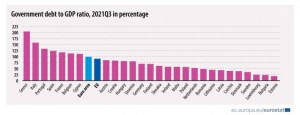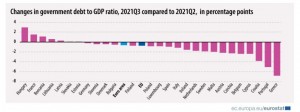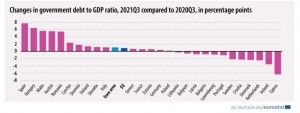January 21, 2022
The government debt to GDP at the end of the third quarter of 2021 in the euro area was £11,731.49 billion, which is 97.7% of GDP. In comparison to the second quarter, debt amounted to £11,607.75 billion, 98.3% of GDP. Relative to the third quarter of 2020 the debt rose from £11,098.57, 96.6% of GDP. It was noted that the third quarter debt was impacted by policy measures adopted to mitigate the economic and social impact of the coronavirus pandemic, which resulted in a rise in financing needs. According to the report published by the Statistical Office of the European Union, “for the euro area and EU, the decrease in government debt to GDP ratio at the end of the third quarter was due to an increase in GDP.” It was also reported that, in the EU, the ratio decreased from 90.9% (£12,617.99 billion) to 90.1% (£12,740.74 billion). Compared to the third quarter of 2020, the government debt to GDP ratio rose in the EU from 89.2% to 90.1%.
In addition, debt securities accounted for 82.7% (£9,705.28 billion) of the euro area and for 82.4% (£10,499.90 billion) of EU general government debt at the end of the third quarter of 2021. Whereas loans constituted 14.2% (£1,661.45 billion) and 14.6% (£1,857.09 billion) in the euro and EU, respectively. Currency and deposits consisted of 3.1% (£364.77 billion) of the euro area and 3.0% (£383.75 billion) of the EU government debt. It was noted, “due to the involvement of EU Member States’ governments in financial assistance to certain Member States, quarterly data on intergovernmental lending (IGL) are also published. The share of IGL as percentage of GDP at the end of the third quarter of 2021 accounted for 1.9% in the euro area and to 1.6% in the EU.”
Government debt at the end of the third quarter 2021 by Member State
Notably, at the end of the third quarter of 2021, the highest ratios of government debt to GDP were observed in Greece (200.7%), Italy (155.3%), Portugal (130.5%), Spain (121.8%), France (116.0%), Belgium (111.4%), Cyprus (109.6%), and the lowest in Estonia (19.6%), Bulgaria (24.2%) and Luxembourg (25.3%).

In comparison to the second quarter of 2020, seven Member States experienced a rise in their debt to GDP ratio at the end of the third quarter of 2021 and twenty registered a decrease. Notably, “The largest increases in the ratio were observed in Hungary (+2.9 percentage points – pp), France (+1.5 pp) and Romania (+1.1 pp), while the largest decreases were recorded in Greece (-6.6 pp), Portugal (-4.9 pp), Croatia (-3.7 pp), Cyprus and Belgium (both -2.3 pp), Czechia (-2.2 pp), and Austria (-2.1 pp),” according to Eurostat.

Fifteen Member States reported growth in their debt to GDP ratio at the end of the third quarter of 2021 in comparison to the third quarter of 2020 and twelve Member States a decrease. The largest increases in the ratio were recorded in Spain (+7.8 pp), Hungary (+6.5 pp), Malta (+5.7 pp), Austria (+5.6 pp) and Romania (+5.5 pp), while largest decreases were observed in Cyprus (-6.4 pp), Ireland (-3.6 pp), the Netherlands (-2.5 pp), Denmark (-2.4 pp), Croatia (-2.3 pp) and Sweden (-2.2 pp).

Disclaimer
Company Disclosure -The information contained herein has been obtained from sources believed to be reliable, however, its accuracy and completeness cannot be guaranteed. You are hereby notified that any disclosure, copying, distribution, or taking any action in reliance on the contents of this information is strictly prohibited and may be unlawful. Mayberry may effect transactions or have positions in securities mentioned herein. In addition, employees of Mayberry may have positions and effect transactions in the securities mentioned herein.
